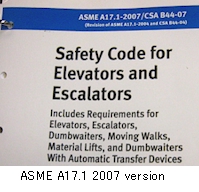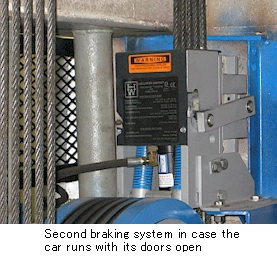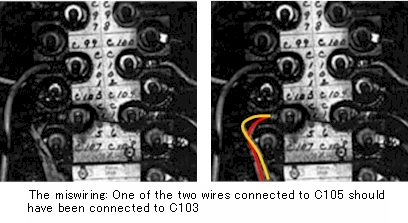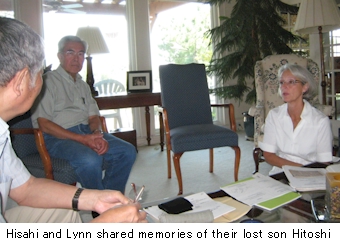ASF tour to Texas
- Loss of a Gold-Headed Cane
"Yes, this is Mike"
It all started with a friendly reply to an overseas call I made from our ASF Hongo office on August 6th.
Dr. Hatamura and I had plans to visit Texas to meet with an issei Japanese American,
a medical doctor Hisashi Nikaidoh, who lost his son in an elevator accident at Christus St. Joseph Hospital in Houston,
Texas on August 16, 2003.
It happened almost 3 years before the Minato-ku accident that took the life of a high school boy
as he was getting off from the elevator when it suddenly start to ascend with its doors open.
The Nikaidoh case shook Texas and probably all the remaining 49 states,
due to its gruesome outcome. Dr. Hitoshi Nikaidoh was caught between the closing doors of an elevator,
which then started to move up and took most of his head with it. His female coworker was trapped in the car
for over an hour with the upper part of Hitoshi's head.
The cause was miswiring in the control box during maintenance;
the elevator did not detect that its doors were still open and took off following the controller command.
Dr. Hatamura, learned about this Houston case through one of his personal doctors after the
2006 case in Minato-ku. With his mind set to visit where it happened, meet with people that know about the case,
and see what caused it, Dr. Hatamura and I started to plan the tour to Houston and Dallas.
The state of Texas has almost 700 square kilometers giving it
the second place in the largest state list in the US next to Alaska, and its population of 24 million ranks the second most
populated state following California.
The Texas population is about 1 fifth of the 127 million living in Japan whose entire area is only a little over
half of Texas. The city of Houston hosts a population of over 2.2 million, and Dallas about 1.3 million.
Houston ranks number 4 in the most populated cities and Dallas number 8. In terms of Metropolitan Statistical Area,
Dallas-Fort Worth-Arlington ranks 4 with 6.3 million, and Houston-Sugar Land-Baytown number 6 with 5.7 million.
My generation, when we hear "Texas", think of the movie "Giant" starring James Dean, and the TV series
"Dallas," and Dallas Cowboys of NFL, Houston Rockets and Dallas Mavericks of NBA, and Texas Rangers and Houston Astros of MLB.
But more recently, we know Houston for Johnson Space Center that directs Space Shuttle missions.

We first tried to get an appointment with the lawyer that handled the Nikaidoh case.
After weeks of communication with his secretary, we finally gave up and decided just to visit the hospital where
the accident took place and have an interview the following day with Hisashi, the father of Hitoshi.
But wait! Dr. Hatamura is traveling all the way from Japan and I am from San Jose.
There's got to be a way to meet with other people that knows about the accident! And that is when I started to search the INTERNET for some pointers. I then found
the page by the State of Texas titled "Elevators, Escalators and Related Equipment Safety and Licensing."
This caught me by a total surprise. The state of Texas has pages dedicated to
licensing and regulations for elevators and escalators! That is something I would never dream I can find in the homepages of the government of Tokyo.
It did not take long before I wrote an e-mail to the State of Texas requesting an interview.
As I expected, I received a swift reply from a person in the state government with a pointer to Mr. Mike Dorosk.
I quickly checked the time difference and dialed the number in the reply mail, and that is when I heard "Yes, this is Mike."
I think I kept talking for at least three minutes explaining who we are, why we were visiting Texas,
and why we wanted to meet with Mike.
Talking on the phone can be very different in the US.
In Japan, the listener often utters some voice to assure the speaker that he/she is listening.
Everytime I tried the American way of listening, the speaker had to stop and ask "Are you there?"
to make sure I was. So now, I go the Japanese way here, that is to make some noise every few seconds
so the speaker would feel better.
People in the US are not bothered by the silent listener.
One side can go on for minutes before pausing to hear some reply from the other.
Talking to an English speaking person on the phone is thus probably the most difficult task for a Japanese businessman.
Kensuke Tsuchiya, now an Associate Professor at the University of Tokyo and a long time
member of the Association for the Study of Failure, decided to join us to hear what Mike had to say about
elevators and escalators. After all, when it comes to gathering crucial information from another person,
nothing beats a live talk by the person himself. The three of us left the hotel with plenty of time, located the
city building and went into a nearby McDonald's before knocking on the door.
When we walked in Mr. Alvin Wright, Senior Staff Analyst -Office of the Director for the City of Houston, welcomed
us with a big smile. He came rushing from what we thought was the back. It turned out that Alvin was waiting for
us at the front of the building and we went in from the rear side.
We then found Mike and the party of 5 walked up the stairs to the conference room.

Mike Dorosk, a Mechanical Senior Inspector for the City of Houston, started
with an overview of regulations for elevators and escalators in the US and the City of Houston. The city has the most
stringent set of regulations for elevators and escalators throughout the US.
Here, inspection of elevators and escalators started in the 60's. With the boom of tall buildings in the 80's,
both commercial and residential, inspection work has been outsourced to private companies.
Mike has been working in the field for 27 years.
Elevators in Houston are required to go under a 3rd party inspection every year.
The results are reported to the city who sends a letter to the elevator owner whether each elevator passed
or failed the inspection. If an elavtor fails, the letter specifies a deadline for the owner to correct the trouble.

American Society of Mechanical Engineers (ASME) has published
"A17.1 Safety Code for Elevators and Escalators."
According to the
ASME home page, the first set of codes were printed back in 1921 in a 25 page booklet.
The most recent version is the 2007 edition which has now grown to a 500 page document. Mike is also a member of
the ASME A17 committee.
"The 2000 edition had two new requirements. One is Ascending Car Overspeed, and the other Unattended Car Movement.
The later required elevators to employ a braking mechanism that stops the car in case its doors are open"
said Mike, and he continued
"This is an additional requirement to the main braking system."

This comment shocked us. Elevators in Japan has no such requirement.
If we had learned from the code revision in 2000 in the US and Canada, the 2006 accident most likely could have been avoided.
Mike later took us to the roof of the building and showed us what the second braking system
looked like for the city building elevator.
Since the 1854 Kanagawa Treaty between the US and then Empire of Japan, Japan aggressively learned
from American and European countries. It rapidly increased its power and quickly joined one of the leading countries of the world.
Probably in a manner that was too hasty that pushed Japan to bluntly enter World War II. After the war Japan had to restart its
learning curve. Again the learning force drove Japan up again to the 2nd place after the US in terms of GDP. Japan still holds the second place,
however, since the pop of its bubble economy in the late 80's the growth has slowed down significantly.
It was around 1930 when the military sector gained too much power and misled the country into war,
about 60 years from the overturn of the Shogun era. The war ended in 1945 and another 60 years have passed since then.
Maybe Japan turned too arrogant in the 80's when companies went around buying paintings like Vincent Van Gogh's "Sunflowers"
or such real estate like Pebble Beach Golf Links at Monterey, California or Rockefeller Center in New York City.
Does Japan have a code equivalent to ASME A17.1? I located Section 2 of Part 4 of Chapter 5 in
"Order for Enforcement of the Building Standards Act" containing code requirements for elevators and escalators. When I copied
the statements into MS Word, it turned into a 9 page document. It may be close the 25 page booklet ASME published in 1921.
ASME A17.1 now, however, is a 500 page document with all the almost 90 years of efforts by the A17 committee to work
safety requirements into the code. What has Japan been doing all these years, I wonder. Maybe it is time for us to
start learning again from our overseas friends with a sincere attitude.
Our meeting and tour lasted about 2 hours. We learned much from "Mr. Elevator"
and the visit turned out to be an extremely valuable experience for us, and maybe for the Japanese society.
It is now our turn to make a change for improved safety with elevators and escalators in Japan.
We would like to express our thanks to Mike Dorosk and Alvin Wright.
Before we left the building, Alvin kindly took the photograph of the three of us posing in front of the building.

Our afternoon started with a visit to St. Joseph Medical Center. Among the number
of buildings the hospital owns, the 2003 accident took place on the 4th floor of George W. Strake Building.
It was elevator #14.
As Mike suggested, we went straight to the security office to ask for
permission to look at the elevator and take photographs. After working up the hierarchy and explaining at each step who we were,
the purpose of our visit, and what we wanted to do, we finally received a kind permission by the Vice President of
Marketing and Community Services, Ms. Fritz Guthrie. It must have been a surprise visit to the hospital staff that we talked to.

Elevator #14 in 2003 was an OTIS made one and the maintenance company at the time was KONE (reads koh-ni).
It has since been replaced with a different make and the maintenance company is now different. This is no wonder because the
direct cause of the accident was miswiring after a maintenance work.
We stared at the elevator, and our thoughts wandered into the accident six years earlier.
What an awful thing to happed right inside of a hospital. It took an hour before the rescuers saved the lady trapped
inside the car with part of Hitoshi's head. We took photographs and in a low voice told the escort that we were done and
would leave the building then.
Saturday, August 29th, 2009. Our second day started before the break of dawn. We dropped
off Kensuke at George W. Bush airport. He had to return to Japan a day earlier. The remaining two of us then took off
on an over 300 miles ride north to Dallas. We visited the Nikaidoh residence where we were greeted by Hitoshi's father,
Hisashi, and stepmother, Lynn. A consulting engineer that helped the Nikaidohs at the time of the tragedy later joined our meeting.
It was a quiet neighborhood and the six years seem to have somewhat calmed the once devastated family.
We sat down in the living room and quietly started the conversations. We learned what went through the minds of the
Nikaidohs as they had to go through the sudden news of the accident, tears, followed by taking the case to the court.
"We had no intension of suing them until the hospital later called us and talked about alcohol level in Hotoshi's blood
at the time of the accident" said Hisashi. His voice was still quiet but the memory probably had elevated his emotions.
Nikaidohs had to file a law suit so they could request a DNA test of the toxicology tissue.
The request for the test was not pursued because it was irrelevant to the act of the responsible party.
"I had to do something to recover the honor of my son" said Hisashi.
"There was no way Hitoshi had alcohol in his body on that Saturday morning" continued Lynn.
"Lynn had to go to the media so I could go in to inspect the elevator" said the consulting engineer personally
acquainted with the Nikaidohs. "I found the miswiring on the controller of elevator #14."
His finding led to the settlement of the case with KONE.


Talking with Hisashi and Lynn, we learned about Hitoshi. He was such a great person
full of love towards his family members, his co-workers, and those younger generation starting out with their
medical career.
He also often volunteered with the church and was planning on becoming a medical missionary.
He was rewarded a Gold-Headed Cane from the University of Texas, Medical School and
his commencement was just 3 months before the accident.
His death was a loss not only to his family but a big one to the society.
Things happen, but we could do better than just shrugging our shoulders. Many of us now
know that even such machines like elevators could malfunction. Learning about past accidents is the first step.
We should then come up with ways to prevent similar happenings, and this takes our second step into the resolution;
knowing about how accidents happened in the past and trying not to repeat the same mistakes are not enough.
People are not perfect and we make mistakes. We must twist our brain cells so they can squirt out ideas to prevent
the accidents by making it impossible to repeat the error.
Our trip opened our eyes to the advancement that the US has made in its codes and standards.
Japan has much to learn and probably not only in the field of elevators and escalators alone. All the people we met
had one thing in common; we do not want to see the same mistake repeated.
[Kenji Iino]





